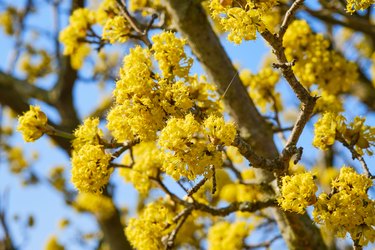
Have you seen a tree that bleeds? While everyone knows that trees don't have blood inside them, they can leak out sap that can be orange or red. This leaking can happen with flowering dogwood trees (Cornus florida, USDA hardiness zones 5-9), so if yours has tree sap that looks like blood, you'll want to figure out what's causing it and determine if you need to do anything about it.
Trees That Bleed Orange
Video of the Day
When you see orange stuff coming out of a tree, which is more likely to appear in the springtime, the likely culprit is a fungus or a complex consisting of fungi and yeast. These invaders can colonize sap when it leaks from tree wounds. The Fusicolla merismoides fungus is the primary one that causes that particular color. Fortunately, this nasty-looking slime is harmless and doesn't cause disease to the trunk, branches or foliage, so while it may look weird, it isn't damaging the tree.
Video of the Day
So, what can you do about a tree that bleeds orange? You can put on a pair of gloves and try scraping it off, but you don't need to unless the branches are failing to foliate or flower. If the tissue beneath the bark has turned brown, the limb has died, and you'll want to prune it off. Green bark is still alive and has a decent chance of re-foliation.
Trees That Bleed Red
Some trees have red sap that looks much more like real blood. This visual sounds scary at first, but it's quite fascinating when you see it. One is the bloodwood tree (Pterocarpus angolensis, USDA hardiness zones 10-12). It has dark red sap that comes out when branches break, and its wood makes high-quality furniture. Aboriginal people also used the sap for wounds, burns and sore eyes.
The bloodwood tree isn't the only red sap tree, though. Others include the eucalyptus (Eucalyptus globulus, USDA hardiness zones 8-11), the dragon tree (Dracaena draco, USDA hardiness zones 9-12, also called Sangre de Grado) and the Indian redwood (Biancaea sappan). Eucalyptus is used as a fresh plant, in its dried form or as an oil for air fresheners. It can treat coughs and fevers, soothe minor aches and pains and repel pests in gardens. Dragon tree blood is used to make polishes for marble, wood, varnishes and paints, and Indian redwood sap is sometimes used for dying textiles.
What Else Do Trees Bleed?
There is a third kind of goo that can leak from trees, and this appears as yellow slime. The condition is called bacterial wetwood and often happens on birch, elm, maple, poplar and oak trees. The symptom is yellow liquid leaking out of trunks and branches, and there can be a lot of it. This liquid can stain bark or leach onto the ground.
This icky problem occurs when bacteria infect a tree after entering through a wound in its roots, trunk or limb. The bacteria can thrive and multiply, building up methane gas, ooze and pressure. Finally, the bacteria gets forced out through the tree's weakest point. It can be clear and brown, resulting in a yellowish-brown stain, and it can also smell horrendous. The slime attracts other bacteria plus fungi and insects, and the whole mess can be toxic to other plants and grass. Unfortunately, there's no cure, but infected trees can live for many years afterward.
- Clemson Cooperative Extension Home & Garden Information Center: Fusicolla Orange Slime on Trees
- Orissa Post: World's Most Unique Tree; 'Blood; Pours Out When You Cut It
- Alice Springs Desert Park: Desert Bloodwood
- Everyday Health: Useful Eucalyptus: The Many Uses of Eucalyptus
- Botanical Garden Munchen-Hymphenburg: Dracaena draco: The Dragon Tree